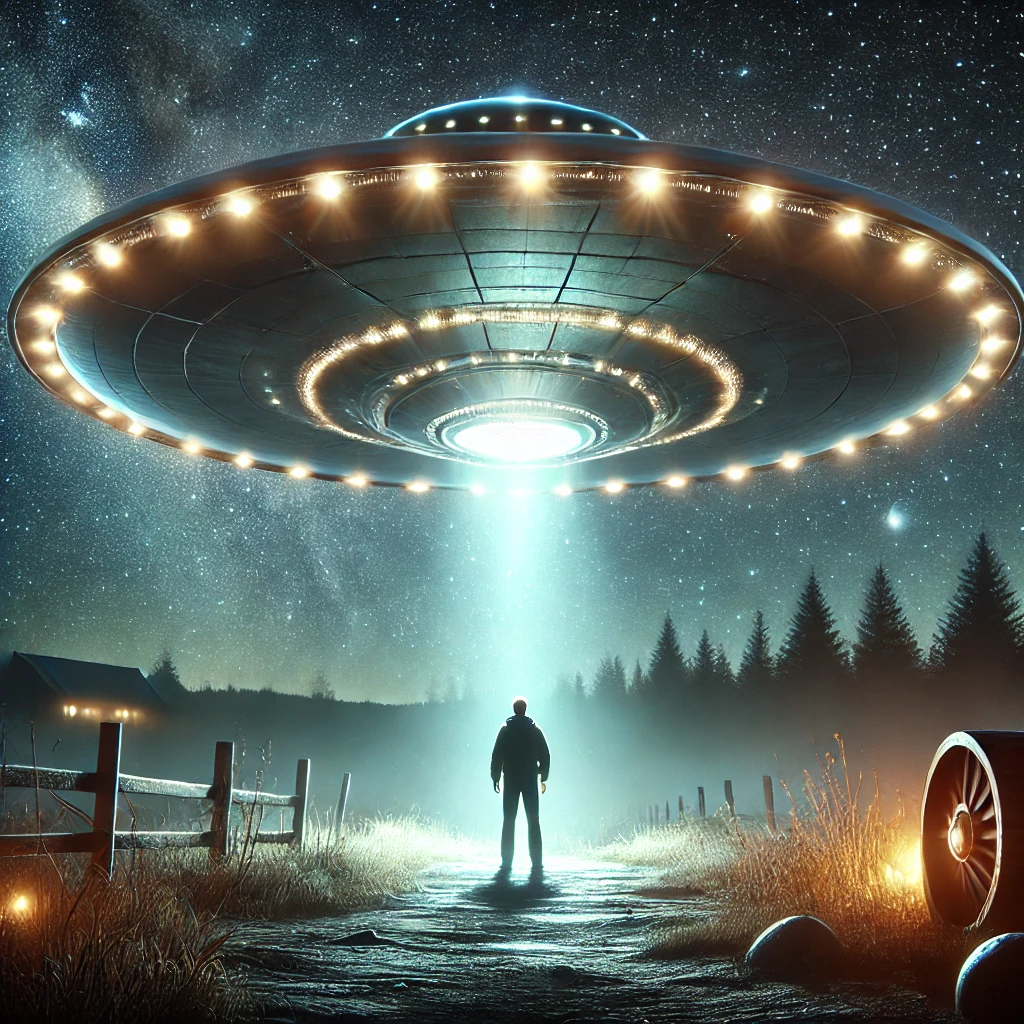A Close Encounter of the First Kind (CE-1) refers to a UFO sighting within 500 feet (152 meters) of the observer. The term originates from the classification system developed by Dr. J. Allen Hynek, an astronomer and UFO researcher, in his 1972 book The UFO Experience: A Scientific Inquiry.
Unlike higher-level encounters, CE-1 experiences involve no direct interaction between the observer and the unidentified flying object (UFO). The objects are often described as displaying unconventional movements, unusual luminosity, or structured designs that do not match known human-made aircraft.
Hynek’s Close Encounter Classification System
Before understanding CE-1 in detail, it is important to recognize its place in Hynek’s Close Encounter system:
- Close Encounter of the First Kind (CE-1) – A UFO sighting within 500 feet, without physical effects or contact.
- Close Encounter of the Second Kind (CE-2) – A sighting with physical effects, such as burn marks, radiation, electromagnetic interference, or impressions on the ground.
- Close Encounter of the Third Kind (CE-3) – A sighting involving the presence of UFO occupants (aliens or non-human beings) without direct interaction.
- Close Encounter of the Fourth Kind (CE-4) – Alien abduction, where the individual is taken against their will and subjected to examination or communication.
- Close Encounter of the Fifth Kind (CE-5) (Later Addition) – Human-initiated contact with extraterrestrials, often through meditation or consciousness practices.
CE-1 serves as the foundational level of UFO encounters, documenting sightings that may suggest the presence of unknown aerial phenomena.
Characteristics of Close Encounters of the First Kind
While details vary, CE-1 reports often share common elements:
1. Proximity of the UFO
- The object is observed at a distance of 500 feet (152 meters) or less.
- This allows for greater detail, distinguishing it from distant lights or celestial objects.
2. No Physical Effects
- Unlike CE-2, CE-1 encounters do not involve burns, radiation, or mechanical interference.
- There is no evidence left behind, such as ground traces or electromagnetic disturbances.
3. Visual Description of the UFO
- CE-1 cases often describe solid, metallic, or luminous craft with varying shapes:
- Disc-shaped (Flying Saucers) – Classic, dome-topped UFOs.
- Triangular Craft – Often reported in military or mass sightings.
- Cylindrical or Cigar-Shaped Objects – Elongated craft with bright lights.
- Orbs or Spheres of Light – Glowing or pulsating energy-based objects.
4. Unconventional Movement
- Many reports describe objects that:
- Hover silently for extended periods.
- Accelerate instantly without visible propulsion.
- Make sharp-angle turns impossible for known aircraft.
- Disappear abruptly, as if phasing out of reality.
5. Multi-Witness Confirmations
- Some CE-1 cases are observed by multiple witnesses, including pilots, police officers, and civilians.
- Occasionally, these sightings are recorded on radar or captured on video, though evidence quality varies.
Famous Close Encounter of the First Kind Cases
1. Kenneth Arnold UFO Sighting (1947, USA)
- Considered the first modern UFO sighting.
- Arnold, a private pilot, observed nine flying objects moving at unprecedented speeds near Mount Rainier, Washington.
- His description of “saucers skipping on water” led to the term “flying saucers.”
2. Phoenix Lights (1997, USA)
- Thousands of witnesses, including military personnel and the governor of Arizona, observed a massive V-shaped formation of lights over Phoenix.
- The object was silent, enormous, and moved in an unconventional manner.
- The event remains one of the most well-documented mass UFO sightings.
3. USS Princeton & Tic-Tac UFO (2004, USA)
- U.S. Navy pilots encountered a tic-tac-shaped craft performing instant acceleration and hovering maneuvers.
- The craft was confirmed on radar and infrared video, adding credibility to the sighting.
- The case is considered one of the strongest pieces of UFO evidence in modern history.
4. Rendlesham Forest Incident (1980, UK)
- U.S. military personnel stationed at RAF Bentwaters observed a triangular craft emitting bright lights.
- The object maneuvered through trees, hovered, and disappeared at high speeds.
- Military records and official documents confirm the event, though explanations remain inconclusive.
Scientific Explanations & Skepticism
Skeptics argue that many CE-1 cases can be explained by natural or man-made phenomena, including:
1. Atmospheric & Celestial Misidentifications
- Venus, meteors, or satellites are often mistaken for UFOs.
- Ball lightning and plasma formations can create glowing orbs resembling craft.
2. Experimental Military Aircraft
- Some UFOs may be classified stealth aircraft or drones being tested.
- The SR-71 Blackbird, B-2 Bomber, and TR-3B (alleged) have all been mistaken for UFOs.
3. Optical Illusions & Perception Errors
- Motion parallax and human depth perception limitations can make distant objects seem to move erratically.
Despite these explanations, many CE-1 cases remain unexplained, particularly those involving radar-confirmed objects, multi-witness sightings, and physical maneuvering beyond known aircraft capabilities.
Zoological and Paranormal Theories
Some alternative theories suggest that CE-1 sightings may involve non-extraterrestrial explanations, such as:
1. Interdimensional Beings
- Some researchers believe UFOs could be entities from higher dimensions, phasing into our reality.
- This theory suggests that UFOs exhibit behavior more consistent with energy-based manifestations than physical craft.
2. Time Travel Hypothesis
- Some speculate that UFOs may be advanced time travelers from Earth’s future, studying past civilizations.
3. Cryptoterrestrial Theory
- This proposes that an advanced civilization may have lived underground or beneath the oceans, explaining why UFOs are frequently observed near water.
How to Observe & Report a Close Encounter of the First Kind
If you witness a UFO within 500 feet, follow these guidelines:
- Remain Calm & Document the Sighting
- Take photos or videos if possible.
- Note the size, shape, color, and movement patterns of the object.
- Record the time, location, and weather conditions.
- Check for Natural Explanations
- Verify if the object could be a satellite, aircraft, or celestial body using apps like Stellarium or FlightRadar24.
- Report the Sighting
- Submit reports to UFO research organizations such as:
- MUFON (Mutual UFO Network)
- NUFORC (National UFO Reporting Center)
- The Pentagon’s UAP Task Force (US Government)
- Submit reports to UFO research organizations such as:
- Compare with Other Reports
- Look for similar sightings in your area or within the same time frame.
Interesting Facts About Close Encounters of the First Kind
- The majority of UFO sightings worldwide fall under CE-1.
- Many CE-1 encounters occur near military installations or nuclear sites.
- Astronauts and airline pilots have reported CE-1 experiences, lending credibility to some cases.
- Some researchers believe crop circles may be associated with CE-1 events.
- Despite government investigations, many CE-1 cases remain unexplained decades later.
Conclusion
Close Encounters of the First Kind provide some of the most compelling evidence for unidentified aerial phenomena. While some sightings can be explained as natural or human-made objects, others challenge our understanding of physics, propulsion, and intelligence beyond Earth.

